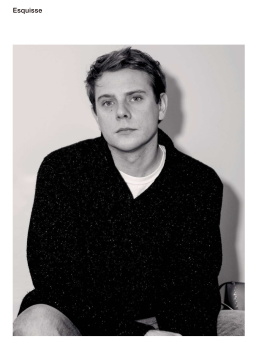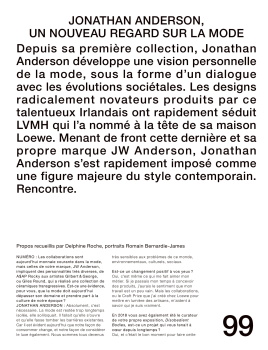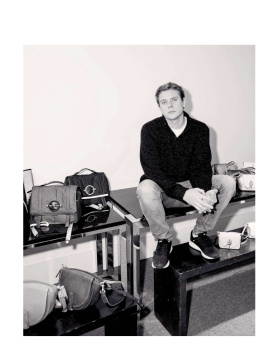The New York Times FEB. 20, 2015
By VANESSA FRIEDMAN
In episode two of our “In the Studio” series, we go inside the workspace of Jonathan Anderson, the 30-year-old British designer behind J. W. Anderson, to discuss the need for efficiency, the difference an LVMH investment makes and the problem with desks (among other burning questions that did not make the final cut). This conversation has been condensed and edited.
JONATHAN ANDERSON: We moved into this building about a year ago. Our old studio is just around the corner, and I wanted to stay in the area because it was somewhere that I grew the brand up. This space is a bit like my house: a bit higgledy-piggledy. Things are never finished. We built everything. We have a lot of wardrobes because that was the only storage we could get. We were all about trying to make these amazing built-in cupboards, but that never happened. Maybe one day. All our chairs came from Tesco.
VANESSA FRIEDMAN: What is important to you about the space?
JWA: I like open, communal spaces. I feel that people work better where there are no divisional walls. We obviously have a couple for meetings. I feel like you put barriers up and people don’t ask questions. I like to float around. I don’t think I’ve ever sat more than 10 minutes at a desk. It’s sort of like a barrier between you and someone so they feel like they’re coming to present something to you. I’m used to sitting on a sofa.
VF: What about the people you work with?
JWA: I’m very into clear-desk policy. I believe that you have to have very clean spaces to work on. If we had wallpaper with a lot of print, or a lot of old collections lying around, or a lot of anything nostalgic, you pick up influence from it, subconsciously, even color. So I have a lot of these large boards that literally everything goes on it, and once we’ve finished, everything comes off it, so that we start from scratch. And I think it forces people to kind of think back onto a blank canvas.
VF: What else is important?
JWA: Light. I really like daylight. Even the lights that we use in the evening are daylight lighting. I feel like you see color better, you see things without them being yellowed. And I like a building that has history. I don’t like a new build. When I first moved to London, I lived in a very modern apartment, and it drove me mad because it felt like every wall was made out of cardboard. But an old building has a soul to it.
VF: How will this space be transformed during the collection?
JWA: The process has become quite methodical. It starts with excessive amounts of research, books upon books upon books upon books of everything from art to ceramics to old editorials to magazines to fashion — anything. And those are all curated into probably 15 to 20 huge, kind of telephone books of imagery. And we sift through everything, to find maybe 20 to 30 images that might represent where we’re going to go.
Then we source all the fabrics we feel are going to work with it. And then we work out the shapes. It’s actually quite a fast process, and not — I don’t want to destroy what we’re doing, make it sound less of a struggle — but it is quite quick. We do the brainstorming, the look, the sketches in a day. And then it is sampling after sampling after sampling.
There are a lot of in-between stages, but the initial idea is done very quickly and it’s never really changed. When you have that initial idea, you cannot change it. That’s my biggest philosophy. There’s no romantic story of redoing the collection the night before, or doing the collection in 48 hours. It’s all very controlled. I don’t like wastage. I don’t think it’s necessary to do a million different samples. Plus, it costs too much money.
VF: It doesn’t make a difference to be partly owned by LVMH, which invested when they made you creative director of Loewe in 2013?
JWA: Being part of a larger conglomerate like LVMH has changed the way in which I view my time and what is important. You realize that you have to become a manager. Ultimately, you want to create a very clean company that feeds itself. I feel like before, I wasn’t efficient enough, and now I’ve become more efficient. But it doesn’t mean we can go on a massive shopping trip. I think that people sometimes have this illusion that, because LVMH has brands like Vuitton and Dior in it, every single brand operates like that. But that’s not really how it works.
VF: They keep you on a tight leash?
JWA: They do, but it’s good, because ultimately it’s got my interest at heart. I own the majority of the company, so it’s important that it stays in good shape.
VF: What are your days like when you’re here?
JWA: I’m usually up by about 6. Some days, I’ve started to do a run, because I smoke, which is very bad and I’ve been trying to give it up. I’m in the office probably just before 9. And we do most design collection work in the morning. I find by the end of the day, I’m better on other things: stores, sales, finance.
VF: Do you draw?
JWA: I’m not a beautiful illustrator like Karl Lagerfeld. The way in which I work is very on-the-body. I find it very difficult to draw flat. I don’t like typing. I find it very difficult to write emails. I’m actually dyslexic so I find it very difficult to take time to do it, and focus. I need to work 3-D.
VF: What do you find hardest?
JWA: The slowdown. I love my work and I’m kind of probably “addicted” is the word. And it’s the minute at the end of Friday that I find the hardest because I’m like, “What do I do?” That may sound awful, but my friends work with me, and I love the adrenaline that it creates, so sometimes I find it very difficult to shut off. A lot of people ask, Are you doing too much? Or: How do you do 10 collections a year for two different brands, and how do you do two different cities? And when it comes to January and February, when you’ve got a men’s show, then another men’s show, a pre-collection, then a women’s wear show, and then another women’s show all in the space of seven to eight weeks — how do you do it? But I get used to the amount of work, and it’s never enough.
VF: What helps?
JWA: I have incredibly good teams. It’s taken me eight years to build my team inside J. W. Anderson. But then sometimes you’re like: “What am I meant to do? Oh, it’s already done, O.K.”
VF: Can you give me an example?
JWA: I’ve been used to doing shows where I would stay up all night, probably due to a lack of focus, or having too much time. But now the collection is done by 10 the night before, and the fittings are all done. When you’re used to doing everything from lint-rolling to dressing models backstage, to lose all that makes you feel you’re not as close to the garments, so you overcompensate. You want to try to rework things. That’s a part I struggle with the most.







